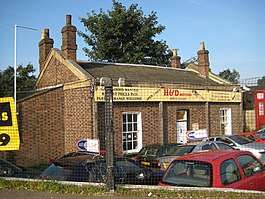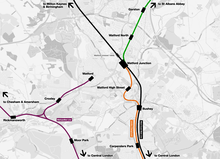Watford railway station (1837-1858)
Watford railway station was a railway station in Watford, Hertfordshire in the UK. It was opened by the London and Birmingham Railway (L&BR) and it was the first railway station to open in Watford. It closed in 1858 when it was replaced by Watford Junction railway station. Today the small ticket office is still standing and it is a Grade II listed building.[1]
| Watford station | |
|---|---|
 The original 1837 Watford railway station | |
| Location | |
| Area | Watford |
| Coordinates | 51.6663548°N 0.3996396°W |
| Operations | |
| Original company | London and Birmingham Railway |
| History | |
| 1837 | Station opened |
| 5 May 1858 | Station closed |
| Disused railway stations in the United Kingdom | |
| Closed railway stations in Britain A B C D–F G H–J K–L M–O P–R S T–V W–Z | |
History
Watford station was situated on the north side of St Albans Road, approximately 300 metres (330 yd) further up the line from the present-day Watford Junction station. This small, single-storey red-brick building was built in 1836–37 when the first section of the London and Birmingham Railway (L&BR) was opened between London and Boxmoor. It was designed by the architect George Aitchison. The station provided first and second-class waiting rooms, a departure yard, a carriage shed and engine house. The platforms were situated in a deep cutting which was accessed via a staircase.[2][3]

By 1839, the station is recorded in the Bucks Herald as having a corrugated iron roof, an engine shed and stationary pumping house with a tall chimney, and a footbridge.[4]
In its 21 years of operation it also served as a station for royalty; in the short period when the Dowager Queen Adelaide was resident at Cassiobury House (c. 1846–1849), this station was remodelled to provide her with a royal waiting room, and it was also reportedly used by Queen Victoria and Prince Albert on a trip to visit Sir Robert Peel in November 1843, when they travelled by road from Windsor Castle to take a train from Watford to Tamworth.[5]
From 1846, the L&BR was absorbed into the London and North Western Railway (LNWR). The old Watford station closed when it was replaced by the larger Watford Junction station, which opened on 5 May 1858. The new station was located south of St Albans Road in order to accommodate the newly constructed branch line to St Albans and later, the Watford and Rickmansworth Railway and the Watford DC Line. The junction station was rebuilt in 1909, and was extensively redeveloped in the 1980s.[6]
The building today
| London and Birmingham Railway | ||||||||||||||||||||||||||||||||||||||||||||||||||||||||||||||||||||||||||||||||||||||||||||||||||||||||||||||||||||||||||||||||||||||||||||||||||||||||||||||||
|---|---|---|---|---|---|---|---|---|---|---|---|---|---|---|---|---|---|---|---|---|---|---|---|---|---|---|---|---|---|---|---|---|---|---|---|---|---|---|---|---|---|---|---|---|---|---|---|---|---|---|---|---|---|---|---|---|---|---|---|---|---|---|---|---|---|---|---|---|---|---|---|---|---|---|---|---|---|---|---|---|---|---|---|---|---|---|---|---|---|---|---|---|---|---|---|---|---|---|---|---|---|---|---|---|---|---|---|---|---|---|---|---|---|---|---|---|---|---|---|---|---|---|---|---|---|---|---|---|---|---|---|---|---|---|---|---|---|---|---|---|---|---|---|---|---|---|---|---|---|---|---|---|---|---|---|---|---|---|---|---|
| ||||||||||||||||||||||||||||||||||||||||||||||||||||||||||||||||||||||||||||||||||||||||||||||||||||||||||||||||||||||||||||||||||||||||||||||||||||||||||||||||
| ||||||||||||||||||||||||||||||||||||||||||||||||||||||||||||||||||||||||||||||||||||||||||||||||||||||||||||||||||||||||||||||||||||||||||||||||||||||||||||||||
The Grade-II-listed Old Station House still stands at 147A St Albans Road, a rare surviving example of architecture from the beginning of the railway age. It is one of two surviving intermediate station buildings in Britain from the early railways, the other being the original Hampton-in-Arden station building, built by the Birmingham and Derby Junction Railway in 1837.[4] Until 2018, the building was occupied by a second-hand car dealership.[7] It currently stands in the middle of a new property development and plans have been announced to convert the building into a craft beer tap room.[8][9][10]
| Preceding station | Historical railways | Following station | ||
|---|---|---|---|---|
| Kings Langley[lower-alpha 1] Line and station open |
London and Birmingham Railway | Harrow[lower-alpha 2] Line and station open | ||
See also
- Watford station – a list of stations past and present
References
| Wikimedia Commons has media related to Watford railway station (1837-1858). |
- Historic England. "The Old Station House (formerly the booking office to Watford Station) (1101109)". National Heritage List for England. Retrieved 19 March 2019.
- Roscoe, Thomas; Lecount, Peter (1839). The London and Birmingham railway, with the home and country scenes on each side of the line. Charles Tilt. pp. 53–54. Archived from the original on 25 May 2015. Retrieved 16 April 2015.
- "Railways". Our Watford History. Watford Museum. Retrieved 19 March 2019.
- "Notes and Extracts on the History Of The London & Birmingham Railway - Chapter 11: The Stations". The Train Now Departing. Archived from the original on 26 March 2019. Retrieved 19 March 2019.
- "The original Watford station". North Watford History Group. Archived from the original on 13 April 2015. Retrieved 13 April 2015.
- Cooper, John (2011). Watford Through Time. Amberley Publishing Limited. ISBN 9781445632032. Retrieved 22 March 2019.
- "Nationally Listed Buildings in Watford". Watford Borough Council. p. 103. Archived from the original on 6 March 2012. Retrieved 13 April 2015.
- Louis, Nathan (14 June 2018). "Plans for 146 flats in St Albans Road in Watford passed". Watford Observer. Archived from the original on 17 July 2018. Retrieved 19 March 2019.
- Sanders, Max. "Report of: Development Management Section Head" (PDF). Watford Borough Council. Retrieved 19 March 2019.
- "Adelaide – 147-149 St Albans Road Watford". gs8.london. GS8. Retrieved 31 March 2020.
Notes
- Prior to 1839, the next station was Boxmoor, now called Hemel Hempstead
- Now called Harrow & Wealdstone.
External links
- Reynolds, Chris. "The Railways at Watford". Hertfordshire Genealogy. Archived from the original on 23 October 2016. Retrieved 28 March 2019.